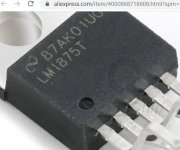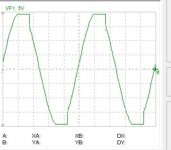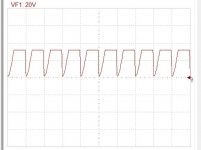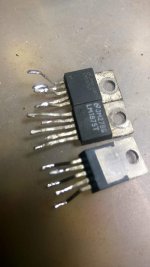As very well explained by Chris, the first project was aiming at discussing how to design BTL composite amplifiers with chip-amps. Six LM1875 is NOT the most straightforward way to get good 100W at the output, but use of the six LM1875 demonstrates a design principle. The voltage source configuration of the chip-amp is probably the most simple also because each stage can be tested individually without a load. I am convinced that current source configuration of the LM1875, or other more sophisticated configurations, will work as well and may require less parallel-trimming. Mr. Joe Rasmussen has very good experience with such configurations.
Please use this thread or open another for new improved variations of the initial concept.
I am not the right person to judge on small details in comparative sound "footprints", neither do I at present have time for more substantial work. Covid has given me urgent tasks to address.
I am looking forward to read about your findings.
Please use this thread or open another for new improved variations of the initial concept.
I am not the right person to judge on small details in comparative sound "footprints", neither do I at present have time for more substantial work. Covid has given me urgent tasks to address.
I am looking forward to read about your findings.
Before all, is to try direct paralleling as I suggested on post 65. According the internal circuitry, the outputs must be high impedance. Unfortunately no one was interested to try out.
On PCB, the amps can be mounted perpendicular to the heatsink to be linked by L shape, by this it becomes compact very simple and to wire.
Rasmussen idea is a standard opamp application not suitable for paralleling.
On PCB, the amps can be mounted perpendicular to the heatsink to be linked by L shape, by this it becomes compact very simple and to wire.
Rasmussen idea is a standard opamp application not suitable for paralleling.
Last edited:
The advantage of Hawland or biphase , it is high output impedance and can be paralleled as many as you need without being concerned about gain difference or offset which is destructive in voltage mode.
Dont u always want lowest impedance at the output?
I have tried both parallel howland current pump 1875 (miniref) and parallel opamp (for headphobe amp) in the past and each time the benefit was clearly audible. But at that complexity the whole thing quiquickly becomes an exercise in novelty rather than practicality, tho the both parallel setups have remained to this day some of the best sound ive heard.
The feedback that loops the opamp and the power current output, the amplifier gets low impedance output.
I have tried both parallel howland current pump 1875 (miniref) and parallel opamp (for headphobe amp) in the past and each time the benefit was clearly audible. But at that complexity the whole thing quiquickly becomes an exercise in novelty rather than practicality, tho the both parallel setups have remained to this day some of the best sound ive heard.
Can you share the schematic plz? Thanks
I decided to take over this subject for the same reason why FF abandoned it, Corona.
I will start a new thread as suggested, as my approach is much different than this, which allows FF to continue it in the future.
The LM1875 for best
I will start a new thread as suggested, as my approach is much different than this, which allows FF to continue it in the future.
The LM1875 for best
Last edited:
Sounds like a good idea with "The LM1875 for best". With your solid experience and vast knowledge of alternative concepts it should take LM1875 performance to further heights.
I am clearly no LM1875 specialist so I will watch the new thread for a better understanding.
FF
I am clearly no LM1875 specialist so I will watch the new thread for a better understanding.
FF
...here you will find...:
https://www.diyaudio.com/forums/chip-amps/341675-ebay-mono-lm1875-kit-5.html#post5896253
https://www.diyaudio.com/forums/chip-amps/341675-ebay-mono-lm1875-kit-5.html#post5896253
Last edited:
Hi everyone,
Does anyone know the maximum watts in 4 and 8 ohms with 2 LM1875 in parallel?
Denis
Does anyone know the maximum watts in 4 and 8 ohms with 2 LM1875 in parallel?
Denis
2 chips are paralleled : the amp will deliver in 4 ohms double than what one chip would deliver in 8 ohms, and in 8 ohms it will deliver double than one chip would deliver in 16 ohms.
Last edited:
This was the picture of fake ones. Does the original resemble to this?
Yes! 🙄 Don't trust on eBay.
Authentic natsemi 1875
The marking(number and latters) colour has changed from white to brown, laser marked maybe. Beware of fake lm1875 from eBay or chinese vendors, fake white colour version is also available there. I never heard a 1875 amp so this is the first time i placed an order for it, definitely genuine lm1875t! 😎
The marking(number and latters) colour has changed from white to brown, laser marked maybe. Beware of fake lm1875 from eBay or chinese vendors, fake white colour version is also available there. I never heard a 1875 amp so this is the first time i placed an order for it, definitely genuine lm1875t! 😎
Attachments
Last edited:
Hi guys, I just found this very interesting tread.
I'd like to share my experience with LM1875 and hopefully to encourage all who are interested in that small veteran chip.
Though almost 30 years old that small chip still can amaze with its sound if used properly.
I did not have time to read all postings so if my post duplicates some other post, please ignore it.
There are many well known advantages of the composite topology.
Current sharing (paralleling) approach offers great benefits as well.
That is why combining both sounds very compelling.
Some time ago I built a composite amplifier based on LM1875. Here is a brief summary:
- THD and noise bellow -125dB (the limit of my measuring gadgets) 0.1 to 40W - 2 parallel LM1875 amps
- less then 1mv DC output, usually between 0.2 and 0.5mV.
- no servo
- no Feedback DC decoupling
- stable in wide range of supply voltages (up to +-30V)
- unity gain stable (not good idea because of the high CM distortion)
- easy to get up to 150W /8ohm combining parallel and bridge 6 LM1875.
- no trace of annoying current limiting feature
I have built a big number of these amps and the sound quality easily beats many other power amps that I owned during the years, including:
- Hypex UCD 250 with super regulators,
- ICEpower 200AC
- TPA3251 and TPA3255 with air coil output filters (the original boards came from 3e-audio but to get a decent sound I had to mod the output filters and input stage as well)
- different LM3886 and TDA7293 topologies (Not composite amps, for these I'll share me experience some other time).
I did not have the opportunity to compare my amps with Modulus-86 power amp but I'll be very happy to do that.
It took me some time of research and experiments but the result repays generously.
I'd like to share my experience with LM1875 and hopefully to encourage all who are interested in that small veteran chip.
Though almost 30 years old that small chip still can amaze with its sound if used properly.
I did not have time to read all postings so if my post duplicates some other post, please ignore it.
There are many well known advantages of the composite topology.
Current sharing (paralleling) approach offers great benefits as well.
That is why combining both sounds very compelling.
Some time ago I built a composite amplifier based on LM1875. Here is a brief summary:
- THD and noise bellow -125dB (the limit of my measuring gadgets) 0.1 to 40W - 2 parallel LM1875 amps
- less then 1mv DC output, usually between 0.2 and 0.5mV.
- no servo
- no Feedback DC decoupling
- stable in wide range of supply voltages (up to +-30V)
- unity gain stable (not good idea because of the high CM distortion)
- easy to get up to 150W /8ohm combining parallel and bridge 6 LM1875.
- no trace of annoying current limiting feature
I have built a big number of these amps and the sound quality easily beats many other power amps that I owned during the years, including:
- Hypex UCD 250 with super regulators,
- ICEpower 200AC
- TPA3251 and TPA3255 with air coil output filters (the original boards came from 3e-audio but to get a decent sound I had to mod the output filters and input stage as well)
- different LM3886 and TDA7293 topologies (Not composite amps, for these I'll share me experience some other time).
I did not have the opportunity to compare my amps with Modulus-86 power amp but I'll be very happy to do that.
It took me some time of research and experiments but the result repays generously.
- Home
- Amplifiers
- Chip Amps
- LM1875 in parallel configuration and used in a composite amplifier.



